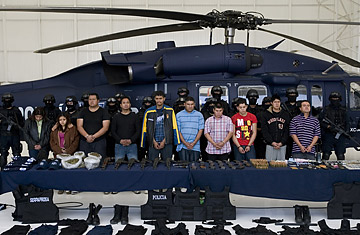
Suspected members of a crime gang accused of extorting, kidnapping and drug trafficking are shown to the press in Mexico City,
Organized Crime and its Threat to Security:
Tackling a Disturbing Consequence of Drug Control
United Nations Office on Drugs and Crime
16 pages
The Gist:
Though advances have been made in the long suffering effort to contain international drug use and production, a parallel surge in drug-related organized crime has popped up as a unfortunate and unintended consequence. Antonio Maria Costa, Director of the United Nations Office on Drugs and Crime, addresses this nasty side effect in a paper slated for delivery at the UN Commission on Narcotic Drugs in Vienna on March 11th. Costa urges countries to "look at drug control as a series of inter-related factors where each intervention has an impact on others," emphasizing the need to incorporate innovative and inclusive crime prevention methods in all efforts to reduce the drug problem rather than tackling each measure individually.
Highlight Reel:
1. On why the drug business has become a security threat: Drug traffickers use their war chests to attack vulnerable countries through business acquisitions, corruption and violence. These processes inevitably converge, as at stake is more than just money laundering and intimidation: drug cartels buy more than real estate, banks and business. They buy elections, candidates and parties. In a word, they buy power. (Read "Mexico's Drug War Takes to the Barricades.")
2. On why Sweden is setting a good example: Prisons are not used to house users, but to deal with trafficking and the crimes attendant to the black market. Streamlined criminal procedures have greatly improved the performance and reduced the cost of taking traffickers out of the equation...Sweden can now boast annual drug use rates less than half the average in West and Central Europe. (Read "The Way Station for Europe's Cocaine.")
3. On why standard law-enforcement methods have failed: Gang members, whose whole life revolves around conflict with the police, value prison as an expected part of the life cycle, and see death as a price to be paid for posthumous respect. [Drug-related] arrests and seizures do not have a lasting impact on them.
4. On what can be done: The drug trade tends to infect societies through open wounds: derelict neighborhoods and out of control regions run by war/drug lords. Situational crime prevention instruments can heal these wounds and make them inhospitable to the drug barons. The emphasis in each case is to regain control over marginalized areas, to draw them in rather than push them out of society.
The Lowdown:
Costa's kill-two-birds-with-one-stone approach to drug control focuses on changing the economic and social conditions in areas susceptible to drugs and drug-related crime, which will in turn provide a long-term solution to the drug epidemic. The approach includes social reintegration of addicts and dealers, firmer legislation against slum real-estate lords who allow illicit activity to continue on their grounds, and the general transformation of the "urban wastelands" that have become breeding grounds for the drug market. Along with trying to motivate UN member states into action on this initiative, the paper is a veiled effort to silence pro-drug lobbyists that have used the increase in organized crime as ammunition for their campaigns to lift controls on drug use — a measure that Costa considers a "cynical resignation of the state's responsibility to protect the heath of its citizens."
The Verdict: Skim
